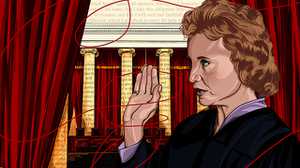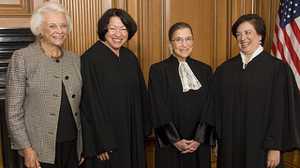Sandra Day O’Connor and Ruth Bader Ginsburg Changed the Supreme Court, and the Country
Despite their differences, the first and second female Supreme Court justices found common ground on women’s equality.

By the time the nation celebrates the birth of its democracy each Fourth of July, the nine justices of the Supreme Court have mostly left town. But before departing the capital for their summer recess, they must first decide all the cases they have heard since their current term began the previous October. The hardest, most controversial cases, where the unelected Court orders the society to change in a big way, are often left to the end. As the days for decision tick away in late June, the tension in the courtroom is as hot and heavy as the Washington summer air.
On the morning of June 26, 1996, Justice Ruth Bader Ginsburg, the second woman appointed to the high court since its founding, slipped through the red velvet curtain behind the bench and took her seat at the end. Five places along the majestic curve sat Justice Sandra Day O’Connor, since 1981 the first woman on the Supreme Court, or the FWOTSC as she slyly called herself. Each woman justice sported an ornamental white collar on her somber black robe, but otherwise there was no obvious link between the First and Second, any more than between any of the other justices. On that day, however, the public got a rare glimpse at the ties that bound the two most powerful women in the land.
Speaking from the depths of the high-backed chair that towered over her tiny frame, Justice Ginsburg delivered the decision of the Court in United States v. Virginia. From that morning in June 1996, Virginia’s state-run Virginia Military Institute, which had trained young men since before the Civil War, would have to take females into its ranks. The Constitution of the United States, which required the equal protection of the laws for all persons, including women, demanded it.
Women in the barracks at VMI. Women rolling in the mud during the traditional hazing, women with cropped heads and stiff gray uniforms looking uncannily like the Confederate soldiers VMI had sent to the Civil War a century before. Six of Ginsburg’s “brethren” on the Court agreed with her that VMI had to admit women, but the case was much more contentious—and momentous—than that robust majority of seven reflects. Until that day, VMI had been the shining symbol of a world divided between men’s and women’s proper roles. Before the case got to the Supremes, the lower federal courts had supported VMI’s sex-segregated ways. For years, opponents of feminism used the prospect of women in military settings as the prime example of how ridiculous the world would become if women were truly treated as equal to men. VMI was one of the last redoubts. And now Justice Ginsburg, who, years ago as Lawyer Ginsburg, had been the premier advocate for women’s equality—the “Thurgood Marshall of the women’s movement”—was going to order the nation to live in that brave new sex-equal world.

Few people listening knew that Ginsburg got to speak for the Court that morning, because her sister in law, O’Connor, had decided she should. After the justices voted to admit women to VMI at their regular conference, the most senior member of the majority had the right to assign the opinion to any justice who agreed. He assigned it to the senior woman, Sandra Day O’Connor, but she would not take it. She knew who had labored as a Supreme Court lawyer at the American Civil Liberties Union from 1970 to 1980 to get the Court to call women equal. And now the job was done. “This should be Ruth’s,” she said.
On decision day, justices do not read their whole opinions, which can often run to scores of pages. That morning, Ginsburg chose to include in her summary reading a reference to Justice O’Connor’s 1982 opinion in Hogan v. Mississippi, which had prohibited Mississippi from segregating the sexes in the state’s public nursing schools. O’Connor’s opinion for the closely divided court in Hogan, Ginsburg reminded the listeners, had laid down the rule that states may not “close entrance gates based on fixed notions concerning the roles and abilities of males and females.” And then Ginsburg, the legendarily undemonstrative justice, paused and, lifting her eyes from her text, met the glance of her predecessor across the bench. She thought of the legacy the two were building together, and nodded. Justice Ginsburg resumed reading the opinion.
Every woman in America was in the courtroom that June day in 1996. Whether you were a Supreme Court lawyer or a stay-at-home mom, pro-choice or pro-life, single or married, having sex in the city or getting ready for a purity ball, in their journey to that day, and on that day, these women changed your life. And so of course changed the lives of men as well. Justices O’Connor and Ginsburg have a stunning history of achievement in a wide range of legal decisions. They argued for equality, they were the living manifestations of equality, and, because they took power before the revolution was over, they were in the unprecedented position of ordering equality.
Starting with the admission of serious numbers of women to law school in 1967 and certainly by the time of the Supreme Court decision in Reed v. Reed in 1971, which was decided thanks in part to Ginsburg’s work at the ACLU, the world had begun to change. Laws saying that women were not equal to men (or that men were not as worthy as women) were struck from the statute books, and part of the stereotyped thinking about women’s lives went down the drain with them. In 1981, 10 years after Ginsburg began her crusade at the ACLU, President Ronald Reagan appointed an obscure Arizona appellate judge, Sandra Day O’Connor, to the Court, and the campaign for women’s equality picked up a doughty and determined role model. It was okay to be first, said O’Connor when the word of her appointment came. But you don’t want to be the last.
All movements have heroes. Who gets to the pantheon is often in dispute. But not in this case. Neither of them is perfect, of course, but Justices Ginsburg and O’Connor are unambiguous heroines of the modern feminist movement. And everyone needs heroes. Each had a long, hard journey to the place where their stories peaked. Forty-plus years before the announcement of the decision in the VMI case, Justice O’Connor, then a new law school graduate, had been offered a position as a legal secretary. When Justice Ginsburg arrived at Harvard in 1956, the Law School’s dean asked all nine women students in her class to explain how they justified taking up a place that would otherwise have gone to a man. In the intervening 40 years, O’Connor and Ginsburg traversed that hostile world to the highest point in the profession. To observe how they did it, is to view two very different—and surprisingly similar—journeys to a flourishing life.

O’Connor was appointed in 1981 by a Republican president swept in by a landslide; Ginsburg was put on the Court by a centrist Democrat who had not even won a majority of the popular vote. They came from completely different backgrounds: Republican/Democrat, Goldwater Girl/liberal, Arizona/Brooklyn. Ginsburg, the brunette, opera-loving New Yorker, used to call her blond colleague the Girl of the Golden West. When O’Connor was appointed, Ginsburg, after 10 years in feminist activism, did not even know who she was.
They were not soul sisters. O’Connor, the uncomplaining, open-faced, cheerful, and energetic westerner, was easy for her brethren to accept in 1981. As Justice John Paul Stevens said four decades later, “she never complained or asked for special treatment. And she got her work in on time; she never held us up.” Ginsburg, the brilliant, solitary alumna of the feminist movement, brought an unwavering vision of the Constitution and a lifetime of experience in movement politics when she arrived. She chose chambers on a different floor than all the other justices, in order to get nicer digs. If she didn’t get what she wanted from the Court, she openly pitched an appeal to Congress or, using the media, to public opinion.
But they were sisters in law. Ginsburg has said a thousand times how glad she was that O’Connor was there to greet her in 1993. And how lonely she was after her colleague retired 12 years later. It was an unlikely pair that came to nod at each other from the highest tribunal in America, as they continued the work of transforming the legal status of American women.
An excerpt from Sisters in Law. Copyright © 2015 by Linda Hirshman, reprinted with permission of Harper, an imprint of HarperCollins Publishers.

Linda Hirshman, J.D. and PhD (philosophy), is the author of Sisters In Law: How Sandra Day O'Connor and Ruth Bader Ginsburg Went to the Supreme Court and Changed the World, as well as many other books about American social movements, including, Reckoning: The Epic Battle Against Sexual Abuse and Harassment. Her new book, The Color of Abolition: How a Printer, a Prophet and a Contessa Changed America, will be published in February 2022. She is the author of many opinion pieces, including articles in the Washington Post and the New York Times.







